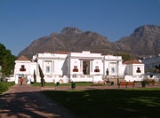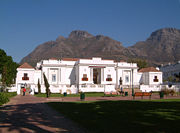
South African National Gallery
Encyclopedia

Art gallery
An art gallery or art museum is a building or space for the exhibition of art, usually visual art.Museums can be public or private, but what distinguishes a museum is the ownership of a collection...
of South Africa
South Africa
The Republic of South Africa is a country in southern Africa. Located at the southern tip of Africa, it is divided into nine provinces, with of coastline on the Atlantic and Indian oceans...
located in Cape Town
Cape Town
Cape Town is the second-most populous city in South Africa, and the provincial capital and primate city of the Western Cape. As the seat of the National Parliament, it is also the legislative capital of the country. It forms part of the City of Cape Town metropolitan municipality...
. The collection began in 1872 with the donation of Sir Thomas Butterworth's personal gallery.
Various other patrons have contributed over the years and the assemblage today consists largely of Dutch, French
France
The French Republic , The French Republic , The French Republic , (commonly known as France , is a unitary semi-presidential republic in Western Europe with several overseas territories and islands located on other continents and in the Indian, Pacific, and Atlantic oceans. Metropolitan France...
and British
United Kingdom
The United Kingdom of Great Britain and Northern IrelandIn the United Kingdom and Dependencies, other languages have been officially recognised as legitimate autochthonous languages under the European Charter for Regional or Minority Languages...
works from the 17th to the 19th century. This includes lithographs, etching
Etching
Etching is the process of using strong acid or mordant to cut into the unprotected parts of a metal surface to create a design in intaglio in the metal...
s and some early 20th century British painting
Painting
Painting is the practice of applying paint, pigment, color or other medium to a surface . The application of the medium is commonly applied to the base with a brush but other objects can be used. In art, the term painting describes both the act and the result of the action. However, painting is...
s.
Contemporary art work displayed in the gallery is selected from many of South Africa's communities and the gallery houses an authoritative collection of sculpture
Sculpture
Sculpture is three-dimensional artwork created by shaping or combining hard materials—typically stone such as marble—or metal, glass, or wood. Softer materials can also be used, such as clay, textiles, plastics, polymers and softer metals...
and beadwork.
Contemporary exhibitions (non-exhaustive) 2010
1910 - 2010 From Pierneef to Gugulective: A Fresh Look at a Century of South African ArtUs
Curated by Riason Naidoo, Iziko South African National Gallery reopens after six weeks with a comprehensive re-hang of the entire gallery. The exhibition reflects on South Africa's contribution to Modern and Contemporary art with a diverse selection of work charting the scope of artistic production in the country over the last century. Visitors can look forward to seminal pieces by early twentieth century artists like Gerard Benghu and Jacob Hendrik Pierneef, through to contemporary artists like Robin Rhode, Mary Sibanda, Andrew Putter and the Gugulective.
Us curated by Bettina Malcomess and Simon Njami, is a continuation of a show that took place in 2009 at Johannesburg Art Gallery. It takes as its starting point the xenophobic violence of May 2008 and focusses on the 'twin' - that which is the same but different - as its central motif. The exhibition explores issues such as aspiration, ownership and security; the connectedness of immigration, trade and movement in Africa; national identity and leadership; the representation of sexuality and desire; and the constitution of religious community. It also reflects on the notion of the African Contemporary itself, as well as the museum's own display of traditional and art objects.
As it is re-configured at Iziko South African National Gallery, it forms an integral part of the re-hang of the collection, '1910 to 2010: from Pierneef to Gugulective'. It will shift and change over the six month period in which it is displayed with the addition of new works, artists and curatorial interventions. In addition a Show within a Show within a Show (>>>) At The End Of The Day is a work presented concurrently by the Museum of Contemporary Art (South Africa).
Talk to Us
Contemporary exhibitions (non-exhaustive) 2009
Dada South? Exploring Dada legacies in South African art 1960 – the presentThe critically acclaimed exhibition Dada South? is one of the first locally-produced, independently curated museum exhibitions in South Africa that focuses on a major international art movement of the 20th century, but from the perspective of recent South African art.
Curators Roger van Wyk and Kathryn Smith present a special programme in the last two weeks of the exhibition, including a two-day public symposium and closing weekend talks featuring South African and visiting scholars, curators and artists.
Drawing together the first collection of historical Dada works ever seen in South Africa, as well as an eclectic range of works by South African artists representing an assortment of experimental and underground positions, the exhibition proposes a review of the ambivalent relationship between cultural creation and political resistance, as well as how art historical ideas are received and interpreted in response to specific, local conditions.
Dada South? also invites consideration of another set of questions: What significance did African art hold for Dada and how do we understand their ideas about Africa? How are their counter-rational, collaborative and interdisciplinary strategies, dating back nearly 100 years now, still so resonant in contemporary art today? In particular, what does a Dada attitude to the political and spiritual reveal about individualism, collectivism and ethics in art today? As Marcel Duchamp said, “When you tap something, you don’t always recognize the sound. That’s apt to come later.” Could Dada be the only 20th century movement that still exists?
As a movement founded by exiles and migrants, Dada challenged notions of territoriality, nationality, ownership and prescribed identity. Dada’s lack of allegiance to any style or ideology, as well as its political and aesthetic contrariness offers an alternative lens through which to view creative tactics and tendencies in contexts which have experienced radical political change.
Whether we ask ‘What is Dada?’ or ‘What is not-Dada?’ (which is a rather Dada question), some of the topics covered include the relationship between Dada and Africa; the cultural underground and related periodicals; art practice as a tactics of action; relationships between forms of art and political agency; the tensions between institutions and experimentation; and counter-rational strategies (absurdism, chaos and chance) as methods for innovation.
Keynote speakers include renowned Dada scholar Marc Dachy (Paris, FR); curator Susan Hapgood (New York, USA); performance theorist Jean Johnson-Jones (Surrey, UK) and artist and social provocateur Nina Romm (Johannesburg, ZA). Other speakers include Belinda Blignaut, Willem Boshoff, Fred de Vries, Kendell Geers, Thembinkosi Goniwe, the Gugulective, Stacy Hardy, Ashraf Jamal and James Sey, among many others.
Adrian Notz (Cabaret Voltaire, Zurich), Lia Perjovschi (artist, Romania), The Trustees (artist group, South Africa), Josh Ginsberg (artist, South Africa) and John Nankin (artist, South Africa) will present talks and performances at the closing weekend.
PARTNERS
Dada South? is presented by the Goethe-Institut, the National Arts Council of South Africa, Pro Helvetia, Mondriaan Foundation, Embassy of France in South Africa, Institut Francaise d’Afrique du Sud, University of Stellenbosch, Iziko Museums of Cape Town, Institut für Auslandsbeziehungen, Stuttgart; BHP Billiton, and the generous support of private donors.
The Dada South? symposium and closing weekend is made possible through the additional generosity of Vivien Cohen, Culturesfrance, Pro Helvetia, Goodman Gallery, Iziko Museums of Cape Town and the Romanian Cultural Institute, Bucharest.
LENDERS
Lenders to the exhibition include the Institut für Auslandsbeziehungen, Stuttgart; Berlin Gallery, Landes Museum Berlin; John Heartfield Archive of the Academy of Arts, Berlin; Goethe-Institut Collection, Munich; Kunsthaus Zürich; Bellerive Museum, Zürich Museum of Design; Centre Pompidou, Musée national d’art moderne collections, Paris; De Stijl Archives, Netherlands Institute for Art History, Den Haag; Johannesburg Art Gallery; Iziko South African National Gallery; Gauteng Legislature; Sasol Museum, University of Stellenbosch; BHP Billiton; Wits Art Galleries and private lenders.
Contemporary exhibitions (non-exhaustive) 2008
Touching MomentsCurated by Loyiso Qanya, Lerato Bereng, Nonkululeko Mlangeni, Bongani Mkhonza and Ntando Xorile.
"Procedure, after all, has been followed in each case, and, as any bureaucrat will tell you, this is much more important than the phantom stuff of truth"
Tom Morton, 2005. Maurizio Cattelan
Maurizio Cattelan
Maurizio Cattelan is an Italian artist based in New York. He is known for his satirical sculptures, particularly La Nona Ora , depicting the Pope John Paul II struck down by a meteorite....
: Infinite Jester, in The artist’s joke, 2007, edited by Jennifer Higgie. London, Cambridge: MIT, Whitechapel: 205-211.
Permanent collection artists (non-exhaustive)
Dan Halter, Willem Boshoff, Barend de Wet, Kathryn Smith, Jane AlexanderJane Alexander
Jane Alexander is an American actress, author, and former director of the National Endowment for the Arts. Although perhaps best known for playing the female lead in The Great White Hope on both stage and screen, Alexander has played a wide array of roles in both theater and film and has committed...
(The Butcher Boys
The Butcher Boys
The Butcher Boys is a plaster sculpture by South African artist Jane Alexander. The work consists of three lifesize humanoid beasts with powdery skin, black eyes, broken horns, and no mouths sitting on a bench...
), Alan Davie
Alan Davie
James Alan Davie is a Scottish painter and musician.He was born in Grangemouth and studied at Edinburgh College of Art in the late 1930s. An early exhibition of his work came through the Society of Scottish Artists...
, Marlene Dumas
Marlene Dumas
Marlene Dumas is a South African born artist and painter who lives and works in Amsterdam, The Netherlands. Stressing both the physical reality of the human body and its psychological value, Dumas tends...
, Robert Hodgins
Robert Hodgins
Robert Hodgins was a British-born South African artist, best known for paintings and printmaking.-Life history:Robert Hodgins was born in Dulwich, London, on 27 June 1920, and immigrated to South Africa in 1938...
, William Kentridge
William Kentridge
William Kentridge is a South African artist best known for his prints, drawings, and animated films. These are constructed by filming a drawing, making erasures and changes, and filming it again. He continues this process meticulously, giving each change to the drawing a quarter of a second to two...
, Ronald Kitaj, Michael Porter
Michael Porter
Michael Eugene Porter is the Bishop William Lawrence University Professor at Harvard Business School. He is a leading authority on company strategy and the competitiveness of nations and regions. Michael Porter’s work is recognized in many governments, corporations and academic circles globally...
, Gerard Sekoto
Gerard Sekoto
Gerard Sekoto , was a South African artist and musician. He is recognized as the pioneer of urban black art, social realism, and more recently as the father of South African art and of his 8 daughters and 3 sons...
, Penny Siopis, Irma Stern
Irma Stern
Irma Stern was a major South African artist who achieved national and international recognition in her lifetime.-Life:...
, , Gary Wragg,

